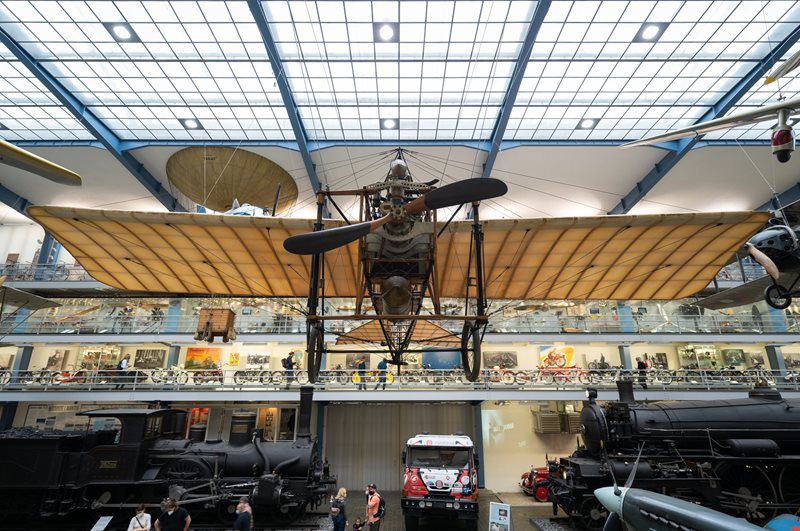1. Skeleton of a Blue Whale (National Museum, Prague)

The enormous skeleton of a blue whale is one of the largest natural history exhibits in Czechia. The skeleton of this fully grown female, measuring 22.5 metres in length and weighing approximately four tonnes, provides a fascinating insight into the anatomy of these gigantic creatures. After undergoing reconstruction, the skeleton is now a highlight of the exhibition Miracles of Evolution in the historic building of the National Museum in Prague.
2. Reliquary of Saint Maurus (Bečov nad Teplou Castle)

The Reliquary of Saint Maurus, along with the Czech royal coronation jewels, is one of the most valuable goldsmith’s treasures in the Czech Republic. It is also one of the most precious goldsmith’s artefacts in Europe. Dating back to the 13th century, it contains skeletal remains of St. John the Baptist, St. Maurus, St. Apollinaris, and St. Timothy. Interestingly, the reliquary was lost for several centuries and only rediscovered in 1985 at Bečov nad Teplou Castle, sparking great interest among historians and archaeologists. It is considered one of the most significant finds of its kind in Europe.

3. Czech Coronation Jewels (Prague Castle)

The Czech Coronation Jewels are among the most significant national treasures, displayed irregularly at Prague Castle. Since 2024, President Petr Pavel has initiated their exhibition on the national holiday of St. Wenceslas. The collection includes the St. Wenceslas Crown with its cap, cushion, and case, the royal orb with its case, the royal sceptre with its case, and the coronation robe.
4. Tatra 87 of Hanzelka and Zikmund (Technical Museum, Kopřivnice)

The legendary Tatra 87 automobile, in which renowned Czech travellers Jiří Hanzelka and Miroslav Zikmund journeyed across Africa, Asia, and Latin America in the 1950s. This unique vehicle is distinguished by its aerodynamic design, which was highly advanced for its time. Equipped with a V8 engine and a streamlined profile, the Tatra 87 became a symbol of Czech engineering and adventure.
5. Jan Kašpar’s Aeroplane (National Technical Museum, Prague)

This unique aircraft, designed and built in 1910, was the first Czech aeroplane to complete a successful flight. Jan Kašpar became a pioneer of Czech aviation, and his aeroplane remains a lasting symbol of his determination and the technological progress of the time.
6. Astronomical Instruments (National Technical Museum, Prague)
Astronomical instruments from the era of Tycho Brahe are unique artefacts that showcase the advancements in astronomy during the 16th century. Used by the renowned Danish astronomer, these instruments enabled detailed observations of celestial bodies and significantly contributed to the development of space science.
7. Dinosaur Tooth (Moravian Museum, Brno)

The only tooth of a carnivorous dinosaur ever found in Czechia was discovered in Brno. It is on display as part of the palaeontology exhibition.
8. Czech Garnet (Museum of the Bohemian Paradise, Turnov)

A unique collection of jewellery and minerals featuring Czech garnet, renowned for its beauty and distinctive deep red colour. The museum’s collection includes not only garnets in various shapes and sizes but also historical pieces that illustrate the evolution of this gemstone from the Middle Ages to the present day.
9. Lithuanian Treasure from Helfštýn (Archaeological Museum, Olomouc)

The Lithuanian treasure from the monumental Helfštýn Castle, which has undergone an award-winning reconstruction and attracts artistic blacksmiths from around the world each year, exhibited at the Museum in Olomouc, specifically at the Museum of Art.. Visitors can admire valuable jewellery, coins, and other artefacts that were part of this fascinating medieval discovery.
10. The World’s Largest Funeral Carriage (Čechy pod Kosířem)

In the small village of Čechy pod Kosířem, home to a historic château, visitors can admire a unique and the largest Central European collection of over a hundred historical carriages. Among the most precious exhibits is the Golden Carriage, crafted in France in 1750, and the archbishop’s carriage, which appeared in films such as Amadeus, Sissi, and The Vampire Wedding. One of the most fascinating pieces is the world’s largest funeral carriage. This gigantic vehicle measures six and a half metres in length and stands three and a half metres tall.
11. Venus of Dolní Věstonice (Moravian Museum, Brno)

Our selection concludes with the extraordinary Venus of Dolní Věstonice! This ceramic figurine of a naked woman from the Upper Palaeolithic is considered the oldest known ceramic statue in the world. It was discovered in Czechia on 13 July 1925 in the ash pit of a prehistoric settlement—now a well-known wine-growing region. This historical rarity is not regularly exhibited, but in 2025, we will commemorate the 100th anniversary of the discovery of the Venus of Dolní Věstonice. The Moravian Museum in Brno is preparing the Venus 100 project, with its main highlight being an exhibition at the Dietrichstein Palace on Zelný trh, running from 18 June to 13 July 2025. Visitors will have a unique opportunity to view the original figurine from all angles.










